Supply “do” or “does” to complete the questions.
Учебное пособие
“NATIONALCUISINES”
для студентов 2-3 курса специальности 190210 «Технология продукции общественного питания
Москва 2016
Авторы:
Морозова Елена Александровна преподаватель высшей квалификационной категории ГБПОУ Колледж «Царицыно»
Рецензент:
Котова Л.В. - преподаватель высшей квалификационной категории ГБПОУ Колледж «Царицыно»
Пособие предназначена для организации аудиторной работы студентов, обучающихся на базе основного общего и среднего полного общего образования по курсуИностранный язык в профессиональной деятельности по специальности 190210 «Технология продукции общественного питания».
Учебное пособие ориентировано на студентов, владеющих базовыми знаниями в области грамматики английского языка, лексическим запасом и навыками разговорной речи. Характерной особенностью и ценностьюданногопособияявляетсяинтегрированнаяпрофессиональнаясоставляющая в курсиностранногоязыкапоспециальности.
К каждой теме программы в учебном пособии предлагается комплекс разнообразных заданий:
· на активизацию монологической и диалогической речи
· на развитие социокультурной компетенции;
· стимулирующих работу в команде;
· на обоснование собственного мнения по спорным вопросам;
· на самостоятельную исследовательскую работу с использованием Интернет пространства;
· лексико-грамматические упражнения;
Учебное пособие поможет преподавателю эффективно организовать учебный курс по дисциплинес применением инновационных методик в соответствии с ФГОС нового поколения.
Содержание рабочей тетради соответствует рабочей программы по дисциплине и утверждено на заседании кафедры иностранного языкаот … 2016 года.
Введение
Учебное пособие для аудиторных занятий, предназначенное для студентов специальностей среднего профессионального образования, будет способствовать более глубокому усвоению теоретического материала и приобретению практических навыков при изучении дисциплины.
Структура пособия соответствует логике изложения материала, предусмотренной рабочей программой по дисциплине.
Пособие имеет следующие разделы и темы:
Раздел 1
Тема1.1. Французская кухня.
Тема 1.2. Итальянская кухня.
Тема 1.3. Японская кухня.
Раздел 2
Тема 2.1. Вегетарианская кухня.
Тема 2.2. Диетическая кухня.
В пособии представлены различные виды заданий по всем темам: практические и творческие задания, задания на развитие логического мышления, а также задания, направленные на проверку полученных знаний и умений.
Для развития творческой активности студентов предполагается выполнение проектных работ индивидуального, группового или фронтального характера по изучаемым темам с последующей защитой их на занятиях: эссе, устные сообщения, проекты;
Содержание
| Раздел 1 Стр Тема1.1. Французская кухня 1-21 Тема 1.2. Итальянская кухня 21-31 Тема 1.3. Японская кухня 30-38 Раздел 2 Тема 2.1. Вегетарианская кухня 38-44 Тема 2.2. Диетическая кухня. 44-51 Приложения 51-61 |
| Использованная литература 62 |
Раздел 1
National cuisines
French Cuisine
Reading
Exercise 1.
Read the text and retell it
French cuisine is the most famous cuisine in the world.It can be divided into two main branches - regional national and refined aristocratic.
Traditionally, each region of France have their own distinctive cuisine: cuisine from northwest France uses butter, cream, and apples; Provençal cuisine (from the southeast) favors olive oil, herbs, potatoes; cuisine from southwest France uses duck fat, foie gras, mushrooms (cèpes), and gizzards; cuisine from northeastern France is reminiscent of German cuisine and uses lard, sausages, beer. Besides these four general areas, there are many more local cuisines, such as the Loire Valley cuisine famous for its delicate dishes of fresh water fish and Loire Valley white wines, the Basque cuisine famous for its use of tomatoes and chili, or the cuisine of Roussillon akin to Catalonian cuisine. With the movements of population of contemporary life, such regional differences are less noticeable than they used to be, but they are still clearly marked, and one traveling across France will notice significant changes in the ways of cooking and the dishes served.
Moreover, recent focus of French consumers on local, countryside food products (produits du terroir) means that the regional cuisines are experiencing a strong revival in the early 21st century.
Cuisine bourgeoise, which includes all the classic French dishes that are not (or no longer) specifically regional, and which have been adapted over the years to suit the taste of the affluent classes. This type of cooking includes the rich, cream-based sauces and somewhat complex cooking techniques that many people associate with French cuisine. At the 'top end' of this category is what is known as haute cuisine, a highly complex and refined approach to food preparation and kitchen management.
Because this kind of cuisine is what is often served abroad under the name of "French cuisine", many foreigners mistakenly believe that typical French meals involved complex cooking and rich, un-dietetic dishes. In fact, such cooking is generally reserved for special occasions, while typical meals are simpler.
Cuisine du terroir, which covers regional specialities with a strong focus on quality local produce and peasant tradition. Many dishes that fall in this category do not stand out as stereotypically "French," sometimes because regional cooking styles can be quite different from the elaborate dishes seen in French restaurants around the world.
Cuisine nouvelle or nouvelle cuisine, which developed in the 1970s as a reaction to traditional cuisine, under the influence of chefs such as Michel Guerard. This type of cooking is characterized by shorter cooking times, much lighter sauces and dressings, and smaller portions presented in a refined, decorative manner. Its modern, inventive approach sometimes includes techniques and combinations from abroad (especially Asia) and has had a profound influence on cooking styles all over the world.
Food fashions and trends in France tend to alternate between these three types of cuisine; today (2004) there is a distinct focus on cuisine du terroir, with a return to traditional rustic cooking and the "forgotten" flavours of local farm produce. The "fusion" cuisine popular in the English-speaking world is not widespread in France, though some restaurants in the capital have a "fusion" theme, and many modern French chefs are influenced by a variety of international cooking styles.
A meal often consists of three courses, hors d'œuvre or entrée (introductory course, sometimes soup), plat principal (main course), fromage (cheese course) and/or dessert, sometimes with a salad offered before the cheese or dessert.
Breakfast is often a quick meal consisting of slices of French bread with jelly or jam, croissants, pain aux raisins or pain au chocolat along with coffee or tea. Children often drink hot chocolate in bowls along with their breakfasts. Breakfast of some kind is always served in cafés opening early in the day.
Lunch is a two hour mid-day meal, but it has recently seen a trend towards the one hour lunch break. In some smaller towns and in the south of France, the two hour
lunch may still be customary. Sunday lunches are often longer and are taken with the family. Restaurants normally open for lunch at noon and close at 2:30 pm. Some restaurants close on Monday during lunch.
Dinner often consists of three courses, hors d'œuvre or entrée (appetizers or introductory course, sometimes soup), plat principal (main course), and a cheese course or dessert, sometimes with a salad offered before the cheese or dessert.
Speaking
Exercise 2.
Make the dialogue between a waiter and a guest in a French resraurant.
Writing
Exercise 3.
Make the description of the French cuisine using the following phrases:
· Contemparary French cookery makes wide use of …
· French cuisine is famous for/noted for its regional diversity…
· French cuisine is characterized by…
· French main dishes are…
· Desserts are characterized by the dominant use of …..
· Some dishes use…
· The most characteristic and ancient elementsof French cuisine are…
Grammar exercise 4.
Exercise 5.
Chicken fricassee
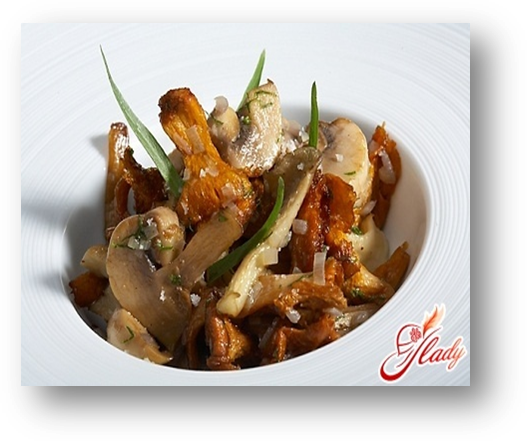 Ingridients:
Ingridients:
· 4 chicken breasts
· 300 grams of fresh mushrooms
· 1 bulb
· 1 segment of garlic
· 50 grams of butter
· 2 tablespoons of flour
· 200 milliliters of cream
· salt, pepper, nutmeg
· saffron
Directions:
1. Saute chicken and mushrooms in a large skillet for 4 to 5 minutes. Remove meat from skillet, add green onions and onion and saute until soft. Set aside.
2. To Make Roux: In a small saucepan stir together butter and flour over low heat; cook until color is caramel and mixture is reduced to 1 cup of roux. Set aside.
3. Put water in a large pot. Add the chicken, mushrooms, onion mixture, celery, seasoning, cayenne pepper, salt, ground black pepper and garlic. Bring all to a boil and cook for 20 minutes. Add 1/2 cup roux and stir together; the mixture should have the consistency of chowder. If necessary, add the remaining 1/2 cup roux.
4. Reduce heat to medium low and simmer uncovered for 2 hours, stirring occasionally. Serve hot over rice, if desired.
Ratatouille
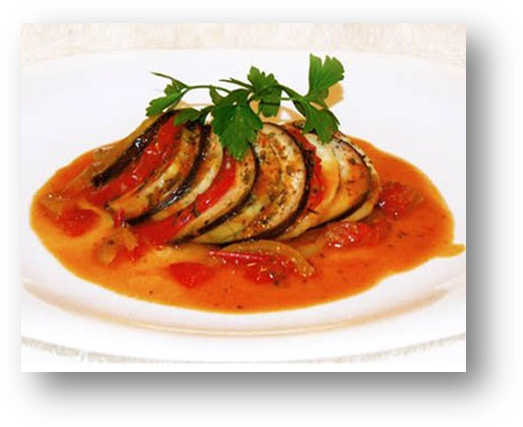 Ingredients:
Ingredients:
· eggplant - 1 piece,
· zucchini or young vegetable marrows - 1-2 pieces,
· paprika - 2 pieces,
· tomatoes - 2-3 pieces,
· onion - 2 pieces,
· greens of fennel and parsley,
· olive or vegetable oil for frying, salt,
· fresh ground pepper
Directions:
1. Preheat oven to 350 degrees F (175 degrees C). Coat bottom and sides of a 1 1/2 quart casserole dish with 1 tablespoon olive oil.
2. Heat remaining 1 tablespoon olive oil in a medium skillet over medium heat. Cook and stir garlic until lightly browned. Mix in parsley and eggplant. Cook and stir until eggplant is soft, about 10 minutes. Season with salt to taste.
3. Spread eggplant mixture evenly across bottom of prepared casserole dish. Sprinkle with a few tablespoons of Parmesan cheese. Spread zucchini in an even layer over top. Lightly salt and sprinkle with a little more cheese. Continue layering in this fashion, with onion, mushrooms, bell pepper, and tomatoes, covering each layer with a sprinkling of salt and cheese.
4. Bake in preheated oven for 45 minutes.
Classical mushroom julienne
Ingredients:
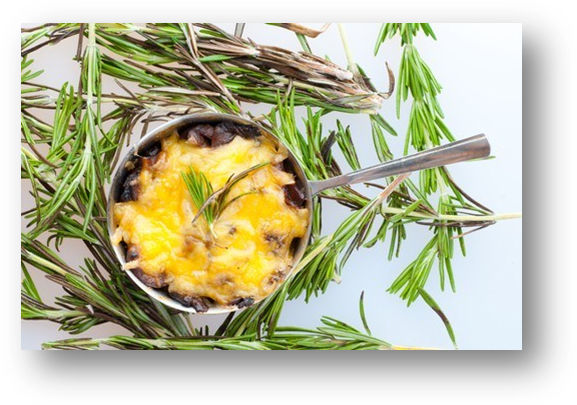
· Mushrooms 100g
· Onions 2 heads
· Wheat flour 1 teaspoon
· Butter 2 tablespoons
· Cream 50 ml
· Cheese 50g
· Salt to taste
· Ground black pepper to taste
Directions:
Classic Potato Gratin
Ingredients: 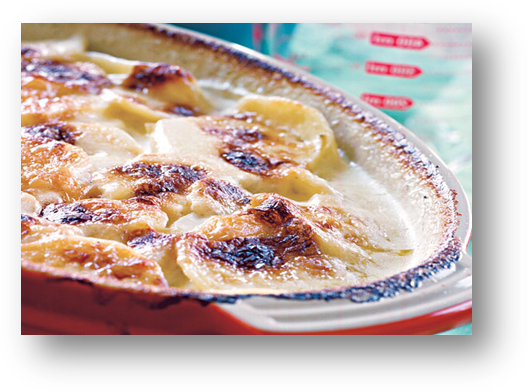
· 2 lb. Yukon Gold or russet potatoes, peeled
· 3 cups whipping or heavy cream
· 1 tsp. kosher salt
· 1/8 tsp. freshly ground blackpepper
· Generous pinch of freshly grated nutmeg
· 2 cloves garlic, peeled and smashed
· 3/4 cup finely shredded Gruyère, Emmental, or Comté
Directions:
1. Heat the oven to 400°F. Using a very sharp knife or a mandoline, carefully cut the potatoes into 1/8-inch slices (no thicker).
2. Put the potatoes in a large heavy-based saucepan and add the cream, salt, pepper, nutmeg, and garlic. Cook the mixture over medium-high heat until the cream is boiling, stirring occasionally (very gently with a rubber spatula so you don't break up the slices).
3. When the cream boils, pour the mixture into a 2-1/2- or 3-qt. baking dish. If you don't want a tender but garlicky surprise mouthful, remove and discard the garlic cloves. Shake the dish a bit to let the slices settle and then sprinkle the surface with the cheese.
4. Bake in the hot oven until the top is deep golden brown, the cream has thickened, and the potatoes are extremely tender when pierced with a knife, about 40 minutes. Don't worry if the dish looks too liquidy at this point; it will set up as it cools a bit. Before serving, let the potatoes cool until they're very warm but not hot (at least 15 minutes) or serve them at room temperature.
Onions soup
Ingredients:
· 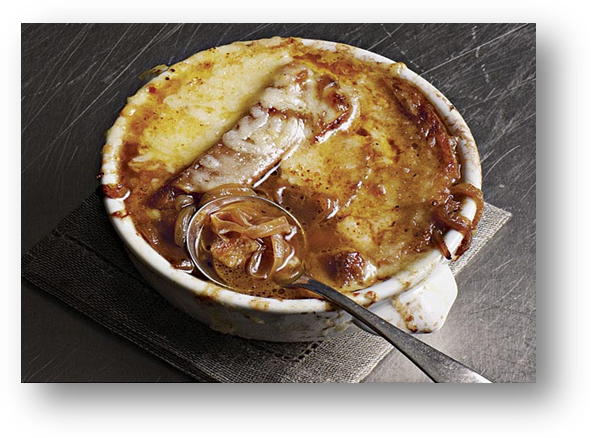 2 oz. (1/4 cup) unsalted butter, more for the baking sheet
2 oz. (1/4 cup) unsalted butter, more for the baking sheet
· 4 medium-large yellow onions (about 2 lb.), thinly sliced (8 cups)
· Kosher salt and freshly ground black pepper
· 1 tsp. Granulated sugar
· 1 small baguette (1/2 lb.), cut into 1/2-inch slices
· 2 quarts Roasted Beef Broth or lower-salt canned beef or chicken broth
· 1 bay leaf
· 2 cups grated Gruyère
Directions:
1. Melt the butter in a 4-quart pot over medium heat. Stir in the onions and season with 1 tsp. salt and a few grinds of pepper. Reduce the heat to low. Press a piece of foil onto the onions to cover them completely, cover the pot with a lid, and cook, stirring occasionally (you will have to lift the foil), until the onions are very soft but not falling apart, 40 to 50 minutes. Remove the lid and foil, raise the heat to medium high, and stir in the sugar. Cook, stirring often, until very deeply browned, 10 to 15 minutes.
2. Meanwhile, to make the croûtes (baguette toasts), position a rack in the center of the oven and heat the oven to 350°F. Butter a rimmed baking sheet and arrange the baguette slices on the sheet in a single layer. Bake until the bread is crisp and lightly browned, turning once, 15 to 20 minutes. Set aside.
3. Add the broth and bay leaf to the caramelized onions and bring the soup to a boil over medium-high heat. Reduce the heat to medium low and simmer for 10 minutes to blend the flavors. Discard the bay leaf and season to taste with salt and pepper.
4. To serve, position a rack 6 inches from the broiler and heat the broiler to high. Put 6 to 8 broiler proof soup bowls or crocks on a baking sheet. Put 2 or 3 croûtes in each bowl and ladle the hot soup on top. Sprinkle with the cheese and broil until the top is browned and bubbly, 2 to 5 minutes. Serve immediately.
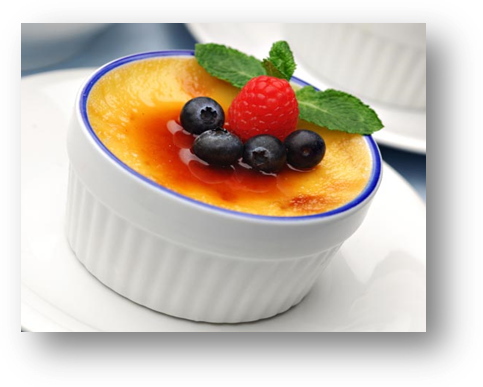
CremeBrulee
Ingredients:
· 500ml (18fl oz) double cream
· 1 vanilla pod
· 100g (4oz) caster sugar (plus extra for the topping)
· 3 egg yolks
· 2 whole eggs
Directions:
1. Preheat oven to 300 degrees F (150 degrees C).
2. Beat egg yolks, 4 tablespoons white sugar and vanilla extract in a mixing bowl until thick and creamy.
3. Pour cream into a saucepan and stir over low heat until it almost comes to boil. Remove the cream from heat immediately. Stir cream into the egg yolk mixture; beat until combined.
4. Pour cream mixture into the top pan of a double boiler. Stir over simmering water until mixture lightly coats the back of a spoon, about 3 minutes. Remove mixture from heat immediately and pour into a shallow heat-proof dish.
5. Bake in preheated oven for 30 minutes. Remove from oven and cool to room temperature. Refrigerate for at least 1 hour or overnight.
6. Preheat the oven to broil.
7. In a small bowl combine remaining 2 tablespoons white sugar and brown sugar. Sift this mixture evenly over custard. Place dish under broiler until sugar melts, about 2 minutes. Watch carefully so as not to burn.
8. Remove from heat and allow to cool. Refrigerate until custard is set again.
Stuffed French toast
Ingredients:
· 3 bananas , peeled and thinly sliced
· 2 tablespoons runny honey
· 100 g pecan nuts , roughly chopped
· 4 slices good-quality sliced white bread
· 4 free-range eggs
· 1 teacup milk
· 1 knob butter
· 1 sprinkle icing sugar
· 1 small tub Greek-style natural yoghurt
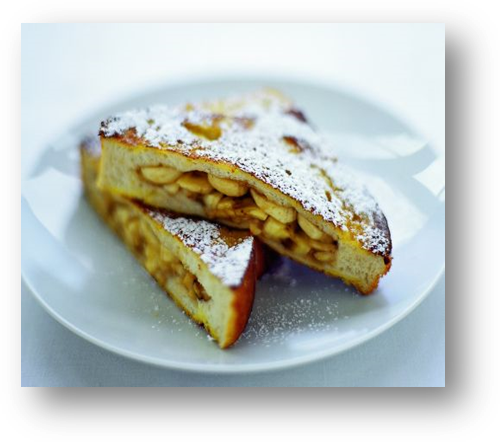
Directions:
1. Mix the bananas together with the honey and the pecan nuts. Divide the mixture equally between 2 slices of the bread, leaving a slight space along the edges of the bread. Top with the other 2 slices to make 2 sandwiches.
2. Heat a frying pan over a moderate heat. Crack the eggs into a bowl and beat in the milk. Dip both sides of the banana sandwiches in the egg mixture.
3. Melt the butter in the frying pan. Fry each sandwich gently for 3 to 4 minutes, turning halfway through cooking, until nicely coloured and warmed through.
4. Dust with the icing sugar, cut in half and serve with the Greek-style natural yoghurt.
French-style chicken
Ingredients:
· 1,8 kg higher-welfare chicken
· For the marinade
· 1 onion , finely chopped
· ½ bulb of garlic , smashed
· 1 small bunch of fresh rosemary , leaves picked and finely chopped
· 4 fresh bay leaves
· 4 tbsp white wine vinegar
For the Florentine potatoes:
· 1,2 kg red-skinned potatoes
· 6 tbsp olive oil
· 4 cloves of garlic , skin on, smashed
· a few sprigs of oregano
For the French dressing
· ½ tsp Dijon mustard
· 6 tbsp extra virgin olive oil
· 2 tbsp white wine vinegar
For the salad
· 4 large handfuls of lamb's lettuce
· 2 frisée , inner white leaves picked and green leaves discarded
· ½ bunch of chives
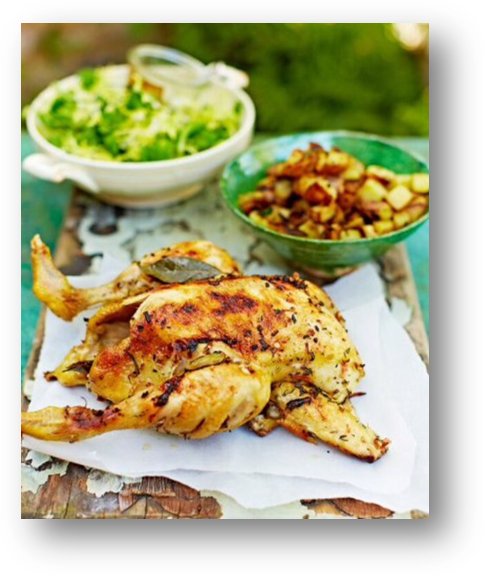
Directions:
1. For me, the best way to cook a whole chicken on the barbecue is to be safe and cook it blonde in the oven first – then finish it on the barbecue to get that crispy, golden skin and let that smoky flavour penetrate right through.
2. Mix all the marinade ingredients together in a large bowl and set aside. Slash the chicken across each leg about 3 or 4 times – this will allow the heat to penetrate directly into the meat and help it cook faster. Place the chicken in the marinade, rubbing the flavour all over.
3. Cover and leave in the fridge for at least 12 hours.Preheat the oven to 190°C/gas 5. Remove the chicken from the brine and pat it dry with kitchen towel, then place in a roasting tray.
4. Cut a lemon in half and pop it inside the chicken’s cavity with the bay leaves from the brine. Cover with a double sheet of tin foil and roast in the oven for 1 hour, until cooked through.
5. Meanwhile, cut the potatoes into rough 2cm cubes and toss in a large roasting tray with a good splash of olive oil, the smashed garlic and the picked oregano. Season with sea salt and black pepper and roast alongside the chicken for about 40 minutes, or until lovely and crispy and golden.
6. After an hour, remove the chicken from the oven and finish on the barbecue, turning occasionally until beautifully golden and crisp all over. Make the French dressing by shaking up the mustard, extra virgin olive oil, vinegar, plus a pinch of sea salt and black pepper, in a jam jar.
7. Add the salad greens to a serving bowl, drizzle over the dressing and toss to coat. Serve the chicken with the crispy potatoes and the salad.
Good old French bean salad
Ingredients:

· 4 handfuls French beans , stalk ends removed
· 2-3 heaped teaspoons French mustard , to taste
· 2 tablespoons good-quality white wine vinegar
· 4 tablespoons extra virgin olive oil
· sea salt
· freshly ground black pepper
· 1 medium shallot , peeled and finely chopped
· 1 tablespoon capers , optional
· ½ clove garlic , finely grated
· 1 small handful fresh chervil , optional
Directions:
1. Bring a pan of water to a fast boil, add your beans, put a lid on the pan, and cook for at least 4 to 5 minutes. Boiling the beans fast like this helps them to retain all their nutrients.
2. Meanwhile, put the mustard and vinegar into a jam jar or bowl and, while stirring, add the olive oil to make a good hot French dressing. Season carefully with sea salt and freshly ground black pepper, then add the finely chopped shallot, the capers if you're using them and the garlic.
3. Remove one of the beans from the pan to check if it's cooked. If it holds its shape but is also soft to the bite, it's perfect. Drain in a colander. Now, while the beans are steaming hot, this is the perfect moment to dress them – a hot bean will take on more of the wonderful dressing than a cold one.
4. It is best to serve the beans warm, not cold, and certainly not at fridge temperature because the flavours will be muted and boring.
5. Serve the beans in a bowl, sprinkled with chervil if you like – it's a delicate, crunchy herb that goes well with beans. Serve as a salad in its own right, or as an accompaniment to a main meal.
Creamy French dressing
Ingredients:
· 5 tablespoons white wine vinegar
· 4 tablespoons walnut oil
· 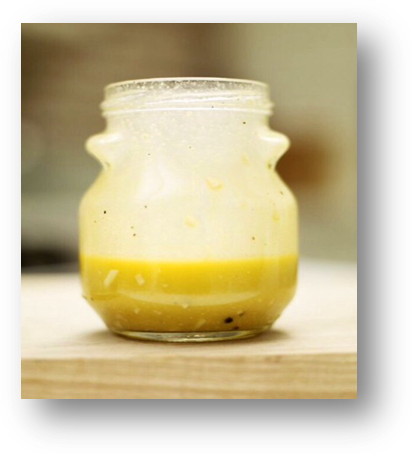 115 ml crème fraîche
115 ml crème fraîche
· 1 teaspoon Dijon mustardsea salt
· freshly ground black pepper
· 1 handful parsley leaves , chopped
· 8 tablespoons best-quality extra virgin oliveoil
Directions:
Put all your ingredients into a jam jar. Shake, taste and season again if needed until your dressing is perfect. You may need to add a little more vinegar or oil to balance it.
French toastie
Ingredients:
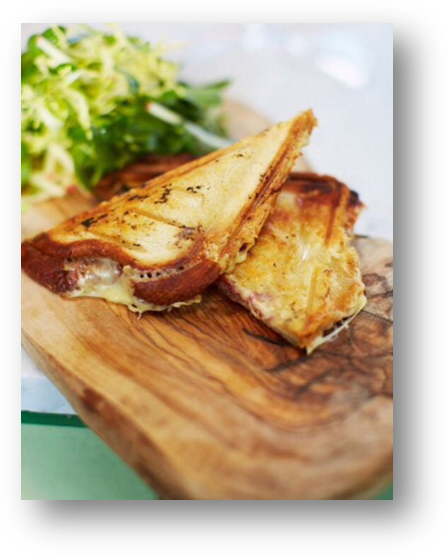
· 2 slices white bread , around 1cm thickunsalted butter
· 15 g Comte cheese
· 15 g Westcombe or artisan Cheddar cheese
· 2 slices higher-welfare roasted ham
· ½ tablespoon white wine vinegar
· 1 tablespoon rapeseed oil
· freshly ground black pepper
· sea salt
· 1 small eating apple
· 1 handful mixed salad leaves , such as frisse,watercress, rocket
Directions:
1. Lightly butter the slices of bread, then place buttered-side down on a chopping board. Slice and lay the cheeses over one piece of bread, top with the ham then place the second piece of bread on top, buttered-side up. Place into a preheated toastie maker, clamp the lid down and toast for 4 to 5 minutes, or until golden and crispy.
2. Meanwhile, add the vinegar and oil to a clean jam jar with a little pinch of salt and pepper, pop the lid on and shake to combine. Cut the apple into matchsticks, removing the core, then toss with the salad leaves and dressing. Serve the golden toastie with the fresh salad on the side, and tuck in.
French-trimmed rack of lamb
Ingredients:
· 2 racks of lamb (each one 8-bone, roughly700g) , French-trimmed, most of the fatremoved
· olive oil
· 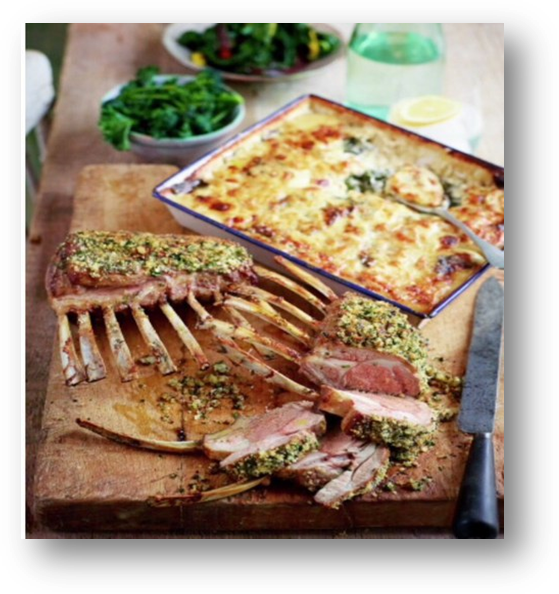 2 tablespoons dijon mustard
2 tablespoons dijon mustard
· 75 g breadcrumbs
· 1 clove of garlic
· 50 g fresh herbs , such as thyme,flat-leaf parsley, rosemary
· 1 lemon
DAUPHINOISE POTATOES
· 1 large red onion
· 2 cloves of garlica few sprigs of fresh thyme
· 150g comté cheese
· 1 knob of unsalted butter , plus extra for greasing
· 2 fresh bay leaves
· kg Maris Piper potatoes
· 200 g baby spinach
Directions:
1. Preheat the oven to 180ºC/350ºF/gas 4. Start by making the potatoes: peel and finely slice the onion and garlic, then pick the thyme. Grate the cheese.
2. Melt the butter in a medium pan over a low heat, then add the onion and thyme and cook for 15 minutes or until sweet and soft, stirring occasionally.
3. Meanwhile, in a separate pan, gently heat the milk and cream over a medium heat, seasoning with sea salt, black pepper, a good grating of nutmeg and the bay leaves.
4. Slice the potatoes by hand or on a mandolin (use the guard!) to around 3mm thick, dropping them into the milk as you go – it’s important not to soak the potatoes in water beforehand as you need the starch to thicken the cream. Cook the potatoes for 5 to 10 minutes, or until just softened, then remove and discard the bay.
5. When the onions are soft, add the garlic and cook for a few minutes, or until golden, then gently stir them into the potatoes, along with a handful of the grated cheese and the spinach.
6. Butter an ovenproof dish, then carefully tip in the potatoes, arranging the top layer neatly. Sprinkle on the remaining cheese, then bake in the oven for about 45 minutes, or until golden and crisp.
7. Once they’re done, take them out and keep warm, then turn up the oven to 220ºC/425ºF/gas 7.
8. For the lamb racks, peel and finely chop the garlic, pick and finely chop the herbs, then finely grate the lemon zest.
9. Season the lamb racks well with salt and pepper, then drizzle with oil. Heat a large frying pan on a high heat and once screaming hot, add the lamb and brown well on all sides for around 6 minutes – you may need to do one rack at a time. Transfer the lamb to a plate and set aside to cool slightly.
10. Using the back of a spoon, spread the mustard evenly over the seared fat. In a bowl, mix together the breadcrumbs, garlic, herbs and lemon zest with a little oil, then pat onto the mustard so the crumbs stick.
11. Transfer the racks to a baking tray and bake for 15 to 20 minutes for medium rare, or a little longer, if you prefer. Allow the lamb to sit for 5 to 10 minutes before carving into chops, then serve with the potatoes and seasonal greens
Chocolate mousse
Ingredients:
 6 oz. semisweet or bittersweet chocolate, preferably 60% to 62% cacao, chopped
6 oz. semisweet or bittersweet chocolate, preferably 60% to 62% cacao, chopped
· 2 Tbs. unsalted butter, cut into 8 pieces
· 3 largeeggwhites
· Pinchoftablesalt
· 3 Tbs. granulatedsugar
· 3/4 cupcoldheavycream
· Chocolate shavings for garnish (optional)
Directions:
1. Put the chopped chocolate in a medium heatproof bowl and set the bowl in a skillet of barely simmering water. Stir the chocolate with a heatproof spatula just until it is melted. Remove the bowl from the skillet, add the butter to the chocolate, and stir until the butter is completely melted and the mixture is smooth.
2. In a medium bowl with an electric hand mixer on medium-high speed (or with a balloon whisk), whip the egg whites and salt until they barely hold soft peaks. While whipping, gradually sprinkle in the sugar—go slowly, as adding it too fast may cause the whites to fall. Continue whipping until the whites just start to hold stiff peaks (see photo below). Don’t overbeat or the dissolved sugar may weep out of the whites.
3. Wipe the beaters (or whisk) clean and then whip the cream in a large bowl until it’s fairly thick and holds a soft peak when the beaters are lifted.
4. With a large spatula, gently fold about onethird of the egg whites into the chocolate until the mixture is no longer streaky. Fold in the remaining whites. Scrape the chocolate mixture into the whipped cream. Add a flavoring, if using (see variatons below). Fold gently until the mixture is uniform in color and texture.
5. Divide among 4 dessert dishes and serve immediately, or refrigerate for at least 30 minutes for a slightly firmer texture. Garnish with chocolate shavings, if using.
Note: The risk of salmonella infection from consuming raw egg whites is low, but the only way to be completely safe is to use pasteurized egg whites.
Variations:
Hazelnut: 3 Tbs. Frangelico
Bourbon: 1 Tbs. bourbon
Coconut: 1/2 cup toasted sweetened coconut (serve immediately to retain texture)
Italian Cuisine
Reading
Exercise 1
Read the text and retell it
Italian cuisine is known and popular worldwide. Everybody knows pizza, pasta and ciabatta. But there are a lot of other delicious dishes. Italian cuisine is characterized by fresh food of the Mediterranean region, which significantly differs the original Italian cuisine from its simulation in the world.
Typical products, used in Italian cuisine are:
different vegetables, wheat flour, cheese, olives and olive oil, spices, fish and, seafood, beef, poultry, beans, fruits (lemons, oranges, peaches) and berries, white mushrooms, almonds, wine, Italian liqueurs, grappa.
Italian cuisine differs from region to region:
Roman cuisine
Sicilian cuisine
Sardinian pastries
Lazio cuisine
Cuisine of Rome is based on seasonal ingredients coming mainly from the Roman Campaign, and a fairly simple way of cooking. It is therefore important ingredients are vegetables, meat (lamb and goat meat) and cheese (Pecorino romano and ricotta).
The island of Sicily for centuries been under the domination of different cultures, so cuisine combines elements of different countries. From these cuisines Sicilian cuisine has adopted a love to spices, as well as to the "exotic" fruits and vegetables (melon, apricots, citrus fruits, sweet peppers).
Sardinian cuisine is based on simple ingredients that originate pastushechih and peasant traditions: bread, cheese and meat. The central role in the kitchen Sardinia got tuna, eel, lobster and other seafood.
The capital of Lazio and the whole Italy is Rome, where the best restaurants and many famous cafes, specializing in ice cream are placed. Extensive use of lamb and veal are typical for regional cuisine and cooking of high quality products is simplified.
Italian cuisine is very popular all over the world, but there are a lot of different dishes, which you haven’t tried yet. Try as many different Italian dishes, as you can, because it's worth it.
Italian cuisine has developed over the centuries. Although the country known as Italy did not unite until the 19th century, the cuisine can claim traceable roots as far back as the 4th century BCE. Through the centuries, neighbouring regions, conquerors, high-profile chefs, political upheaval and the discovery of the New World have influenced its development. Italian food started to form after the fall of the Roman Empire, when different cities began to separate and form their own traditions. Many different types of bread and pasta were made, and there was a variation in cooking techniques and preparation. The country was split. For example, the North of Italy (Milan) is known for its risottos, the central/middle of the country (Bologna) is known for its tortellini and the South (Naples) is famous for its pizzas. Italian cuisine has a great variety of different ingredients which are commonly used, ranging from fruits, vegetables, sauces, meats, etc. In the North of Italy, fish (such as cod, or baccalà), potatoes, rice, corn (maize), sausages, pork, and different types of cheeses are the most common ingredients. Pasta dishes with use of tomato are spread in all Italy.
In Northern Italy though there are many kinds of stuffed pasta, polenta and risotto are equally popular if not more so. Ligurian ingredients include several types of fish and seafood dishes; basil (found in pesto), nuts and olive oil are very common. In Emilia-Romagna, common ingredients include ham (prosciutto), sausage (cotechino), different sorts of salami, truffles, grana, Parmigiano-Reggiano, and tomatoes (Bolognese sauce or ragù).
Traditional Central Italian cuisine uses ingredients such as tomatoes, all kinds of meat, fish, and pecorino cheese. In Tuscany pasta (especially pappardelle) is traditionally served with meat sauce (including game meat). Finally, in Southern Italy, tomatoes – fresh or cooked into tomato sauce – peppers, olives and olive oil, garlic, artichokes, oranges, ricotta cheese, eggplants, zucchini, certain types of fish (anchovies, sardines and tuna), and capers are important components to the local cuisine.
Italian cuisine is also well known (and well regarded) for its use of a diverse variety of pasta. Pasta include noodles in various lengths, widths and shapes. Distinguished on shapes they are named — penne, maccheroni, spaghetti, linguine, fusilli, lasagne and many more varieties that are filled with other ingredients like ravioli and tortellini.
The word pasta is also used to refer to dishes in which pasta products are a primary ingredient. It is usually served with sauce. There are hundreds of different shapes of pasta with at least locally recognized names.
Examples include spaghetti (thin rods), rigatoni (tubes or cylinders), fusilli (swirls), and lasagne (sheets). Dumplings, like gnocchi (made with potatoes) and noodles like spätzle, are sometimes considered pasta. They are both traditional in parts of Italy.
Pasta is categorized in two basic styles: dried and fresh. Dried pasta made without eggs can be stored for up to two years under ideal conditions, while fresh pasta will keep for a couple of days in the refrigerator. Pasta is generally cooked by boiling. Under Italian law, dry pasta (pasta secca) can only be made from durum wheat flour or durum wheat semolina, and is more commonly used in Southern Italy compared to their Northern counterparts, who traditionally prefer the fresh egg variety.
Durum flour and durum semolina have a yellow tinge in color. Italian pasta is traditionally cooked al dente (Italian: firm to the bite, meaning not too soft). Outside Italy, dry pasta is frequently made from other types of flour, but this yields a softer product that cannot be cooked al dente. There are many types of wheat flour with varying gluten and protein levels depending on variety of grain used.
Particular varieties of pasta may also use other grains and milling methods to make the flour, as specified by law. Some pasta varieties, such as pizzoccheri, are made from buckwheat flour. Fresh pasta may include eggs (pasta all'uovo 'egg pasta'). Whole wheat pasta has become increasingly popular because of its supposed health benefits over pasta made from refined flour.
Speaking
Exercise 2
Writing
Exercise 3
Make the description of the Italian cuisine using thefollowing phrases:
· Contemparary Italian cookery makes wide use of …
· Italian cuisine is famous for/noted for its regional diversity…
· Italian cuisine is characterized by…
· Italian main dishes are
· Desserts are characterized by the dominant use of …..
· Some dishes use…
· The most characteristic and ancient elements of Italian cuisine are…
Grammar exercise 4
Exercise 5.
Typical recipes
Rigatoni with roasted tomatoes & ricotta salata
Ingredients:
· 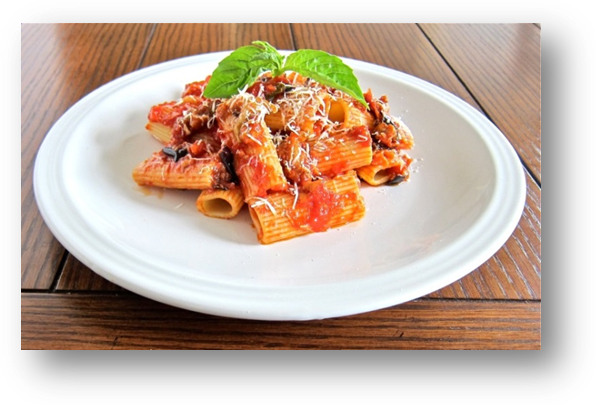 1.5 kg vine tomatoes
1.5 kg vine tomatoes
· 4 cloves of garlic unpeeled
· 3 bay leaves
· 5 thyme sprigs
· a splash of red wine vinegar
· 400 g dried rigatoni
· 80 g ricotta salata
· a small bunch of basil
· leaves picked (optional)
Method of cooking:
1. Preheat the oven to 200C/gas 6. Put the tomatoes on a large baking tray, and season. Scatter over the garlic cloves, thyme sprigs and bay leaves then transfer to the oven and roast for 25 minutes, until the tomato skins are burnished and split. Let the tomatoes cool for a minute or two, then pull them off the vines and place in a frying pan with the red wine vinegar and a pinch more salt and pepper.
2. Squash with a spoon and simmer for 15 minutes, until you have a thick, strawberry-red sauce with an almost creamy consistency.
3. Bring a pan of salted water to the boil and cook the rigatoni according to the packet instructions.
4. Drain, reserving a cupful of cooking water, and add to the sauce with a little of the water to loosen.
5. Drizzle over a good glug of olive oil and serve with grated ricotta and a scattering of basil leaves, if you like.
6.
Pasta peperonata
Ingredients:
· 2 red peppers, deseeded and sliced;
· 2 yellow peppers , deseeded and sliced;
· 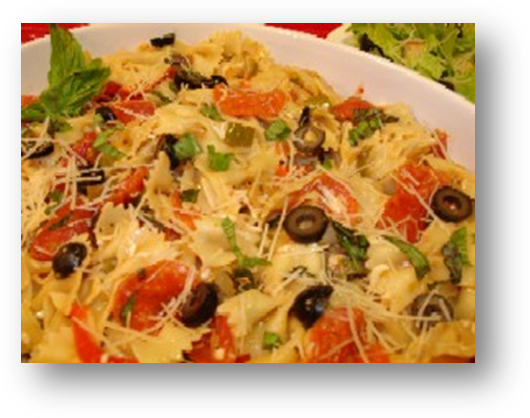 extra virgin olive oil, sea salt, freshly ground black pepper;
extra virgin olive oil, sea salt, freshly ground black pepper;
· 2 red onions , peeled and finely sliced;
· 2 cloves garlic , peeled and grated;
· 2 handfuls fresh flat-leaf parsley , leaves finely chopped, stalks reserved;
· 2 tablespoons red wine vinegar or balsamic vinegar;
· 2 handfuls Parmesan cheese , grated;
· 2 heaped tablespoons mascarpone cheese or crème fraîche , optional;
· 455 g rigatoni, penne or spaghetti.
Method of cooking:
1. Put all the peppers in a large frying pan over a medium heat with a little olive oil and a pinch of salt and pepper. Place a lid on, and cook slowly for 15 minutes until softened. Don't rush this too much, as cooking the peppers slowly like this really helps to bring out the flavour.
2. Add the onion and cook for a further 20 minutes. Then add the garlic and parsley stalks and toss around, keeping everything moving in the pan.
3. Cook for about 3 minutes most. Have a little taste, and season with a bit more salt and pepper. Add the vinegar - it will sizzle away, so give everything a good toss.
4. Then add one handful of the grated Parmesan and the mascarpone or crème fraîche if you are using it and turn the heat down to minimum while you cook the pasta.
5. Meanwhile put a large pot of salted water on to boil. Add the pasta to the boiling water and cook according to the packet instructions. When cooked, drain in a colander, reserving some of the cooking water. Put the peppers, pasta and parsley leaves into a large warmed bowl.
6. Give them a good toss together, then add a little of the pasta cooking water and a few good lugs of extra virgin olive oil to coat the pasta nicely. Serve straight away sprinkled with the rest of the Parmesan.
Chocolate Coffee Tiramisu

Ingredients:
· ½ cup Granulated sugar
· 1½ cups Ricotta cheese
· 3 tablespoonsCocoa
· 1 Egg yolk
· 1 teaspoon Vanilla extract
· 3 Egg whites
· ,½ cup Light cream cheese
· ⅓ cup Granulated sugar
· ¾ cup Strong prepared coffee
· 3 tablespoons Chocolate/coffee-flavored liqueur
Ladyfinger cookies, 16
Method of cooking:
1. Ladyfinger cookies are light, sweet sponge cakes that are shaped like a finger. Firstly, spray some vegetable spray on a 9-inch square baking dish. Then, combine the sugar, cocoa, ricotta cheese, cream cheese, egg yolk, and vanilla extract in a food processor and blend till the mixture smoothens. Once done, transfer it to a bowl.
2. Now, beat the eggs whites in another bowl, and gradually add some sugar to it. Fold this gently into the ricotta mixture. Take a small bowl and combine the coffee and liqueur in it. Place half of the ladyfinger cookies in the baking dish, and spread half of the coffee-liqueur mixture over this. Now, spread half of the ricotta mixture above this. Repeat these layers and cover the dish. Place it in the refrigerator for 3 hours or overnight.
Grilled Mushroom Risotto
Ingredients:
· 6 cups Chicken stock
· 2 tbsp Olive oil
· ¼ cup (finely chopped)Celery
· 1½ cups Risotto rice
· 1 large (chopped)
· 1 cup Dry white wine Onion
· 1 cup (dried)Porchini mushroom,
· 3 cups (sliced)Mushrooms (shitakeand oyster), Parsley, a handful(chopped)
· 1 Juice of lemon
· 1 tbsp Butter
· 2 tbsp Extra virgin olive oil

Method of cooking:
1. Heat the chicken stock in a saucepan and let it simmer over low heat. Place the dried porchini mushroom in a small bowl and pour hot stock over it. After a few minutes, remove the porchini mushrooms from the stock and slice them into small pieces.
2. Heat a large frying pan and add the olive oil. Fry the chopped onions and celery over medium heat until they become soft. Add the rice and sauté till they turn translucent. Pour in the dry white wine and allow the alcohol to get absorbed by the rice. Now pour the hot chicken stock in the rice one ladle at a time and also stir in the sliced porcini. Carry on adding the chicken stock to the rice till all the stock has been used.
3. Grill the oyster and shitake mushroom in a griddle pan until they are soft and browned. Place the grilled mushrooms in a bowl and add the chopped parsley, lemon juice, and a bit of salt. Keep the mushroom aside.
4. When the risotto is done, take it off the heat and stir in the butter and Parmesan cheese, place the lid over the pan and let it stand for 2 minutes. To serve, place the risotto in a plate and top it with grilled mushroom and extra shavings of Parmesan cheese and a good drizzle of extra virgin olive oil.
5. The calorie content of risotto is about 348 per 100 g. of rice. Always serve the risotto immediately or it will turn hard and tasteless. You can also prepare risotto pudding by making a few changes in the basic recipe.
Pasta with Smoked Salmon
Ingredients:
· 1.10 lb Dried Pasta
· 0.55 lb Smoked Salmon 
· 5 oz White Wine
· (grated)Parmesan Cheese
· 5 oz.Carton Double Cream
Method of cooking:
1. Cook pasta in boiling water and drain it. Add some olive oil in order to prevent the pasta tubes from sticking to each other.
2. Bring wine to boil in a large pan. Then add salmon, cheese and cream. Heat it on a low flame.
3. Add this cream sauce to the pasta. Mix it thoroughly and pour it into a serving plate.
4. This dish goes well with some crusty bread and chopped tomato, cucumber and onion salad.
Spinach Pasta from Scratch
 Ingredients:
Ingredients:
· 140 grams of fresh spinach
· 350 grams of pasta of your choice
· 6 cloves of garlic
· 1 tablespoon olive oil
· ½ teaspoon black pepper
· ½ cup grated Parmesan cheese
· Salt as per taste
Method of cooking:
1. Blanche and dry the spinach bunches.
2. Boil the pasta till its soft and fluffy.
3. Meanwhile, chop the spinach and discard it's stem.
4. Once the pasta is cooked, pour the olive oil in a skillet and put the chopped spinach in it, with dried chillies and cloves of garlic.
5. Now add the pasta with a little water and add the grated cheese to the skillet.
6. As the cheese begins to melt and the pasta gets more creamy, sprinkle some black pepper and add a pinch of salt as per taste.
Toasted Ravioli
Ingredients
· 2 dozenFrozen ravioli (meat or cheese filled),
· Eggs (lightly beaten),
· 2Italian seasoned breadcrumbs,
· 1 cupParmesan cheese
· Marinara sauce (for dipping)
· Vegetable oil (for frying)

Method of cooking:
1. Cook ravioli in salted, boiling water untilthey float on the top.
2. Then remove them from water and drain.
3. Keep them aside for cooling.
4. Heat vegetable oil in the fryer to a temperature of about 375 degrees.
5. Dip ravioli in the beaten egg and cover in breadcrumbs.
6. Fry them in hot oil for about 5 minutes, until they turn golden brown and then drain.
7. Sprinkle Parmesan cheese over the hot ravioli.
8. Heat marinara sauce and keep it in the serving bowl.
9. Serve ravioli with the dipping sauce.
Japanese cuisine
Reading
Exercise 1
Read the text and retell it
Japanese cuisine has been influenced by the food customs of other nations, but has adopted and refined them to create its own unique cooking style and eating habits.
The first foreign influence on Japan was China around 300 B.C. , when the Japanese learned to cultivate rice. The use of chopsticks and the consumption of soy sauce and soybean curd (tofu) also came from China.
Rice and noodles are the two primary staples of the Japanese diet. Rice, either boiled or steamed, is served at every meal. Noodles come in many varieties. Among the most popular are soba, thin brown noodles made from buckwheat flour; udon, thick white noodles made from wheat flour; and ramen, thin, curly noodles, also made from wheat flour .
Soy sauce and other soybean products are also staples in Japan. These include miso (fermented soybean paste) and tofu (a soybean curd that resembles custard).
The Japanese are known for using very fresh ingredients in their cooking. They prefer using fresh, seasonal foods for their meals, buying it the same day it will be cooked. The Japanese are also famous for their skill in arranging food so that it looks beautiful. The people of Japan live long lives and have a low rate of heart disease because of healthy eating habits.
Speaking
Exercise 2
Make a dialogue between a waiter and a guest in a Japanese resraurant.
Writing
Exercise 3
Make the description of theJapanesecuisine using the following phrases:
· Contemparary Japanese cookery makes wide use of …
· Japanese cuisine is famous for/noted for its regional diversity…
· Japanesecuisine is characterized by…
· Japanese main dishes are
· Desserts are characterized by the dominant use of …..
· Some dishes use…
· The most characteristic and ancient elements of Japanesecuisine are…
Exercise 4
Translate from Russian into English:
1. Обед будет подан в 12 часов дня.
2. Мясо всегда жарится на сливочном масле.
3. Салат приготовлен сегодня утром.
4. Это блюдо приготовлено шеф-поваром.
5. Утка с яблоками запекается в духовке 2 часа.
6. Сыр для салата «Цезарь» обячно натирают на терке.
7. Фарш для котлет был приготовлен поваром вчера.
8. Вареный картофель, морковь, зеленый горошек, соленые огурцы и вареное мясо – основные составляющие салата «Оливье».
9. Когда в этом отеле подают ужин?
10. Кто готовил это мясо по-французски?
Exercise 5
Typical recipes
Katsu Curry
Ingredients:
 1 tbsp vegetable oil
1 tbsp vegetable oil
· 1 onion, finely chopped
· 1/2 carrot, grated
· 620ml water
· 100g S&B Golden Curry Sauce Mix
· 4 pork loin steaks or chicken breasts
· Salt and pepper
· 50g plain flour
· 1 egg, beaten
· 100g breadcrumbs (preferably panko breadcrumbs)
· Vegetable oil for deep frying
· Cooked rice to serve
Method of cooking:
1. Heat 1 tbsp of oil in a large saucepan, fry the onion and carrot over a medium heat until softened. Add the water, bring to the boil, reduce the heat and simmer for 10 mins. Remove from the heat then add the curry sauce mix, in pieces, stir until completely melted. Simmer gently for another 5 mins, stirring constantly.
2. Season both sides of the pork loin or chicken breasts. Lightly coat with flour, dip in beaten egg and then coat with breadcrumbs.
3. Heat the remaining oil in a large heavy-based saucepan to 170°C / 340°F. Deep fry the meat for 3-4 minutes each side until golden and cooked through. Drain on kitchen paper.
4. Slice the meat, drizzle with curry sauce, and serve with cooked rice.
Hosomaki

Ingredients:
 140g sushi rice
140g sushi rice
· 25g cucumber
· 20g gourd (cut in ribbons)
· 1 sheet nori (21cm x 19cm)
· 475ml dashi
· 2 tbsps sugar
· 2 tbsps soy sauce
· 1 tbsp mirin
Method of cooking:
1. Cut the cucumber lengthways into eighths. Rinse the gourd, rub it with salt, soak it in lukewarm water and then boil it for 4-5 minutes. Place the boiled gourd and A in a pan, bring to a boil, then lower the heat and cook for 10-15 minutes.
2. Cut the nori in half lengthways, and place it on a bamboo rolling mat, spread 70g rice over the sheet leaving 1cm free on the side opposite you. Lay the cucumber or gourd down the centre.
3. Place your thumbs at the back of the mat and lift it whilst supporting the filling with the rest of your fingers. Roll the rice away from you and press lightly.
4. Roll the sushi so that the edge of the nori is placed under the rolled sushi.
To make a neat roll, spread the rice more thinly where the filling is to go.
5. Shape the sushi by pressing each end of the roll, and cut it into 6 pieces. Repeat the process for the other filling.
Rolled Sushi
Ingredients:
 Approximately 100g sushi rice for each hosomaki roll, and 200g for each futomaki roll.
Approximately 100g sushi rice for each hosomaki roll, and 200g for each futomaki roll.
· Toasted nori
· Toasted nori sheets are usually a standard size of 20 x 20cm. For futomaki, these can be used as they are, but for hosomaki, they should be cut in half.
· Tamago (omelette) cut into thin strips
· Unagi (grilled eel) cut into thin strips
· Kyuri (cucumber) cut into sticks
· Kampyo (gourd shavings) cut into ribbons
Method of cooking:
1. Place the makisu on a chopping boad and place a sheet of toasted norion the makisu, ensuring that the shiny, toasted side is facing down.
2. Pick up around 200g of cooked sushi rice, gathering it together lightly with both hands. Be sure to always wet your hands with tezu (vinegared hand dipping water) before you handle the rice.
3. Carefully spread a layer of sushi rice over the surface of the nori, to an even thickness of about 9mm, leaving a slight gap at the edge farthest away from you. Dab a little tezu on the exposed nori at the far side of the sheet.
4. Make a slight groove in the centre of the rice, and place the filling in this groove. Ensure fillings are free of excess moisture. In the case of futomaki, lay out the fillings side by side in the centre of the rice.
5. Carefully begin rolling the makisu from the edge nearest you, using your fingers to keep the fillings in place. Press down tightly and evenly, but not so tightly that the rice and filling comes out the sides.
6. When the makisu has almost completely enveloped the sushi, pull out the end of the mat so that it is not rolled up in the sushi. Holding the makisu around the sushi, pull the other end of the mat gently.
7. Gently press the sides of the roll with the fingers of your hand to flatten, and carefully remove the makisu from around the sushi.
8. Cut the roll in half using a sharp knife that has been dipped in tezu. Then place the two halves next to each other, and cut into thirds. When cutting the completed makizushi, move the knife back and forward with a steady sawing motion.
Healthy Food
Reading
Exercise 1
Read the text and retell it
Food is an essential part of our daily life. It’s very important to choose the right food nowadays. Healthy and balanced diet is useful for every person. We depend on food as well as the cars depend on gas, for example. It’s our natural fuel, which gives our body physical strength and health. When the body is healthy, the mind will also be healthy.
Different types of food contain different nutrients for our body. Some supply us with carbohydrates, some with proteins or fats, some with vitamins and minerals, etc. Many people think that fat is bad for people and they try to cut down on it. There is even a special line of products, called low-fat.
The problem is that we do need some kinds of fat, but the saturated fats from animal products, like red meat, butter and cheese, can be really bad for health. Friendly fats can be found in avocados, nuts and seeds, olives and tuna fish, and in some other products. Some people cut down on too much sugar and salt, which is also a good idea. One of the healthiest types of food is fruit and vegetables. Such organic products can be only useful if they don’t contain any chemicals and additives, which has become a common phenomenon in modern supermarkets.
More and more people tend to grow fruit and vegetables in their own gardens, instead of buying them. Another problem is modified food. It’s much cheaper than ordinary food, which is why people often buy it. From the other hand, modified food can lead to dangerous diseases.
The food people eat depends a lot on their culture, religion, beliefs, health and other factors. However, some rules are common for everyone. They are: less fat, sugar and salt; and more water, vitamins, fresh fruit and vegetables.
Speaking
Exercise 2
Writing
Exercise 3
Make the description of the healthy food using the following samples:
· Healthy food means….
· Healthy food does not use….
· Healthy cookery makes wide use of …
· Healthy food is famous for/noted for its regional diversiti…
· Healthy food is characterized by…
· Healthy food dishes/ desserts are characterized by the dominant use of…...
· The most characteristic elementsof healthy food are…
Exercise 4.
Typical recipes
Apple crumble
Ingredients:
· 3 apples, peeled, cored, and cut into 1-inch chunks
· 1/3 cupapplejuiceorcider
· 1/2 cup all-purpose flour, preferably whole grain
· 1/3 cuprolledoats
· 1/3 cupmaplesugar
· 1/2 teaspooncinnamon
· 1/4 teaspoonsalt
· 4 tablespoonbutter, softened
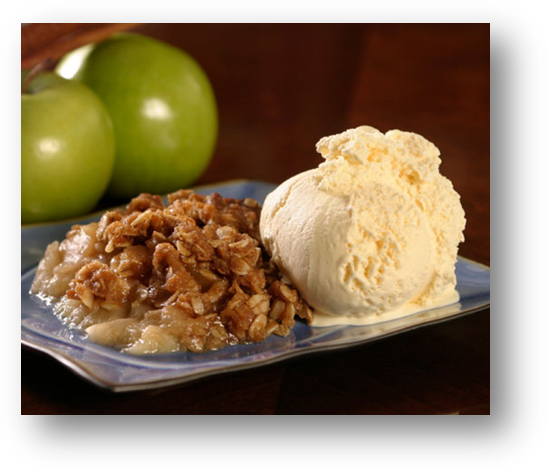
Directions:
1. Preheat oven to 375ºF.
2. Place diced apples and apple juice in a 9 x 9-inch baking dish.
3. Combine flour, oats, maple sugar, cinnamon, and salt in a medium bowl.
4. Using your fingers, work the softened butter into the flour mixture until it looks like crumbs.
5. Top apples with the crumb mixture and bake for 40 to 50 minutes or until golden brown and bubbling.
Chicory salad
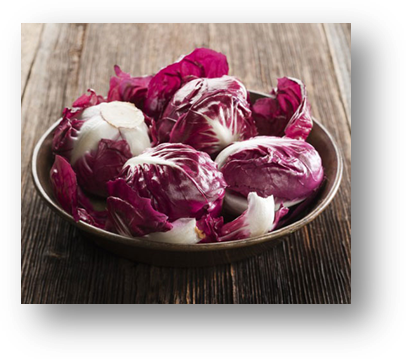 Ingredients:
Ingredients:
· 1 headradicchio, sliced
· 1 headfriséesliced
· 2 tablespoonsmincedshallots
· 2 tablespoons sherryvinegar
· 2 tablespoonsextravirginoliveoil
· 2 teaspoonsshavedParmesan
· 2 cupsslicedpearsorapples
Directions:
1. Mince the shallots and add vinegar; set aside for at least 15 min or up to
